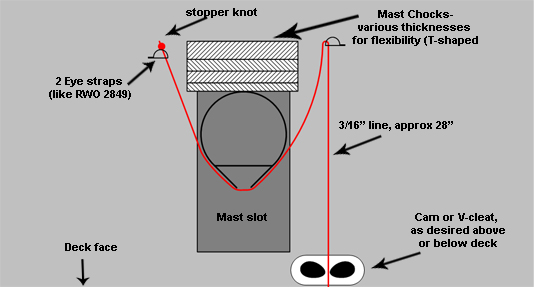Mast Bend Control
A mast pusher or ram controls the mast’s pre-bend and the mainsail’s depth. When the mast is bent, the mainsail can be trimmed tighter which flattens the sail. A flatter mainsail is faster in light and heavy winds. In choppy water, a fuller sail has more power to help accelerate.
There are several ways to control the mast bend at the deck level for keel-stepped masts
1.Put mast chocks or blocks both in front and behind the mast to lock it into position. Move them from front/aft as desired based on wind conditions. The mast wants to bend in heavy air/vang situations and blocks forward of the mast are a solid stop to prevent too much bending.
However, if you have external halyards and topping lift, they may get in the way.
2.Put chocks either in front or behind the mast and use a line on the other side to pull/push the mast as desired. This line can be above or below deck level.
3.Use 2 lines and no blocks.
This is a personal preference discussion. Adjusting on the water is much easier with lines vs chocks but chocks are more solid/fixed for reliability. The attached diagram shows a typical rig where blocks are in front of the mast to limit the mast bend and a line is used to create bend as desired. Removing forward mast chocks and tightening the mast pusher will push the mast forward, bending the mast. If you drill a small hole into the blocks and tie them loosely to the mast, they will not fall out in case of a capsize.
